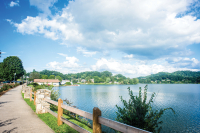Seeking a new chill
By Michael Beadle
Freezing temperatures may keep some people bundled up indoors, but not Adam Fox.
When the temperatures dip into the teens and 20s, it’s prime time for scaling the sides of mountains for an ice climbing adventure.
As the owner and director of Fox Mountain Guides in Hendersonville, Fox sets up guided rock climbing and ice climbing trips throughout Western North Carolina and New England. Some local sites for ice climbing include Graveyard Fields, Linville Gorge, Looking Glass Rock near Brevard, and Whitesides Mountain between Highlands and Cashiers.
Fox started rock climbing about 18 years ago in England and progressed into ice climbing about 10 years ago — first in Scotland and later in the United States. He’s taught rock climbing in the United Kingdom, and has been on climbs in South America, Australia and New Zealand. After coming to work at an outdoor camp in Hendersonville 13 years ago, he eventually became the outdoor adventure program director there. That led him to found his own outfit three years ago. Fox Mountain Guides offers rock and ice climbing adventures for families, individuals, beginners and experienced climbers. It also trains and teaches climbing guides, and runs a rock climbing camp for teens in the summer.
Whether it’s rock climbing or ice climbing, there’s a peaceful feeling Fox gets when he’s working his way up the side of a mountain.
“To me it’s very relaxing,” he says. “Your mind is totally focused on one objective.”
Now is the season for ice climbing, although it can be difficult gauging when conditions are right to ice climb. Temperatures need to be below freezing (32 degrees Fahrenheit) for water to freeze. However, if it gets too cold, the ice may freeze only on a mountain top and not on the side or base of a mountain.
The best time to go ice climbing is in the early morning, Fox explains. In Western North Carolina, the best time of the year is the latter part of December, although ice climbing season may range from late November to late January. Ideally, overnight lows need to be in the 20s Fahrenheit for about four to five days with daytime highs in the low 30s and 40s. On overcast days, the ice won’t generally melt as fast as on clear blue sky days, so it helps to have cloudy days to secure just the right conditions. Fox Mountain Guides includes weather reports on its Web site to keep climbers updated on various ice climbing locations in Western North Carolina.
Even when conditions are perfect, there’s still a short window of opportunity. While at Graveyard Fields near the Blue Ridge Parkway several years ago, Fox and his fellow climbers had a great first day of ice climbing, but that night, they could hear ice crashing down all around. By the next day, the ice was gone.
Michael Lumpkin, an ice climber and outdoors enthusiast from Atlanta, has done his share of ice climbing around Western North Carolina locations such as Winding Stair Gap near Franklin and sites off N.C. 215 near Lake Logan. He travels the country as a Southeastern U.S. sales representative for climbing equipment manufacturer Petzl. For Lumpkin, ice climbing gives you an amazing feeling of accomplishment, knowing you’ve scaled what looked impossible to do. That said, Lumpkin warns that you need to have proper training before you attempt an ice climb.
“Believe it or not, it’s so safe,” Lumpkin says. “The fall rate is very low.”
That’s generally because the ropes used to help climbers are secured to trees rather than fastened into the ice.
While Whitesides Mountain may take hours to ascend, Lumpkin has found shorter ice climbs just off the road that can take five minutes. A half day of ice climbing may entail a series of these smaller climbs.
For those seeking the thrill of ice climbing, Fox has a few tips.
“Good equipment is paramount,” Fox says.
First, it’s important to wear layers of lightweight, synthetic clothing. With cold, wet conditions, you don’t want to have clothing like blue jeans that get cold when they get wet. Wear a sturdy set of plastic or stiff sole boots with crampons, or spikes that attach to your boots to keep your footing on the ice. You will also need a helmet — preferably one with a shield — to protect you from falling rocks or ice or in case you fall. You will need picks or axes — one for each hand — to ascend a mountain slope. Depending on the type of climbing you do, you may also need ropes and screws to secure positions in the climb. With a guided trip, the company usually will provide most of this equipment.
Beyond the equipment and weather conditions, would-be ice climbers need to know that the guide they hire is properly certified, Fox says. Most people assume that when they go ice climbing with professional guides, there’s some kind of certification or license that the guide must have, but that’s often not the case. According to Fox, about 80 to 90 percent of mountain climbing guides are not officially certified by the American Mountain Guides Association, the sole rock climbing guide certification organization in the United States. It’s a good idea to find that out before going on a potentially dangerous rock climbing or ice climbing trek.
For the record, Fox and all of his guides are AMGA certified. For more information about Fox Mountain Guides and for information about becoming a guide, check out the Web site www.foxmountainguides.com.





